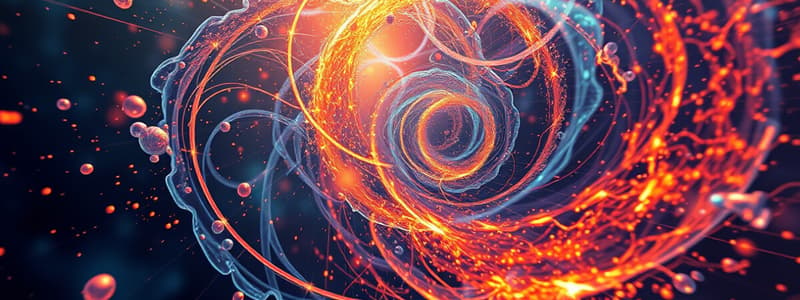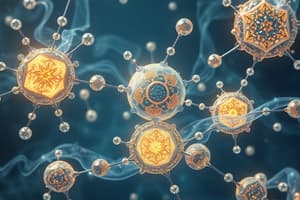Podcast
Questions and Answers
According to the kinetic-molecular theory, what is true about particles of matter?
According to the kinetic-molecular theory, what is true about particles of matter?
They are in constant motion.
According to the kinetic-molecular theory, what causes gases to condense into liquids?
According to the kinetic-molecular theory, what causes gases to condense into liquids?
Forces between molecules.
According to the kinetic-molecular theory, which substances are made of particles?
According to the kinetic-molecular theory, which substances are made of particles?
All matter.
What is an ideal gas?
What is an ideal gas?
How does a real gas differ from an ideal gas?
How does a real gas differ from an ideal gas?
If two moving steel balls collide, what type of collision is this an example of?
If two moving steel balls collide, what type of collision is this an example of?
What is an example of gas diffusion?
What is an example of gas diffusion?
When does the density of a substance undergo the greatest change?
When does the density of a substance undergo the greatest change?
According to the kinetic-molecular theory, how does a gas expand?
According to the kinetic-molecular theory, how does a gas expand?
Under what conditions do real gases most resemble ideal gases?
Under what conditions do real gases most resemble ideal gases?
State the kinetic-molecular theory of matter.
State the kinetic-molecular theory of matter.
List the 5 assumptions of the kinetic-molecular theory of gases.
List the 5 assumptions of the kinetic-molecular theory of gases.
Describe the characteristic properties of gases.
Describe the characteristic properties of gases.
Describe the conditions under which a real gas deviates from 'ideal' behavior.
Describe the conditions under which a real gas deviates from 'ideal' behavior.
Flashcards are hidden until you start studying
Study Notes
Kinetic-Molecular Theory Overview
- Particles of matter are always in constant motion, influencing the state of matter.
- All matter is composed of particles, regardless of its phase (solid, liquid, gas).
Behavior of Gases
- Gases condense into liquids due to intermolecular forces acting between molecules.
- Gas expansion occurs when particles move over greater distances, filling their container completely.
- Density changes significantly when a substance transitions from liquid to gas.
Ideal vs. Real Gases
- An ideal gas is a theoretical concept that perfectly follows kinetic theory assumptions.
- Real gases actively experience intermolecular attractive forces, contrasting with ideal gas behavior.
- Real gases closely resemble ideal gases under conditions of low pressure and high temperature.
Collisions and Energy
- When two moving steel balls collide, retaining total energy is a characteristic of elastic collisions.
Diffusion and Effusion
- Gas diffusion is exemplified by how a perfume's scent disperses throughout a room.
- Effusion occurs when gas particles escape through a tiny opening.
Characteristic Properties of Gases
- Expansion: Gases occupy the entire volume of their container.
- Density: Gases have relatively low density compared to solids and liquids.
- Fluidity: Gas particles can smoothly glide past one another.
- Compressibility: Gases can be compressed due to significant spacing between particles.
- Diffusion: The ability of gas particles to spread out and fill available space uniformly.
Kinetic-Molecular Theory Assumptions
- Gases consist of numerous tiny particles far apart relative to one another.
- Collisions among gas particles and with container walls are elastic, conserving energy.
- Gas particles are in rapid, random motion, contributing to their kinetic energy.
- No intermolecular forces exist between gas particles.
- Average kinetic energy is directly proportional to the gas temperature.
Deviations from Ideal Behavior
- Real gases behave non-ideally under conditions of high pressure and low temperatures, affecting their properties.
Studying That Suits You
Use AI to generate personalized quizzes and flashcards to suit your learning preferences.




